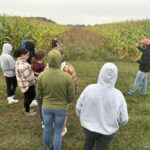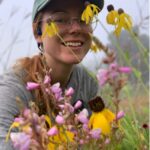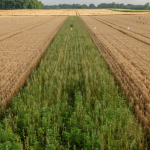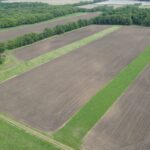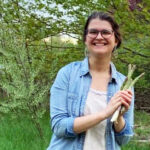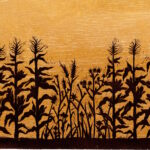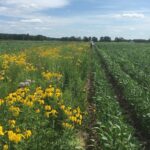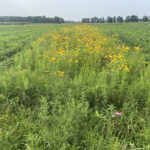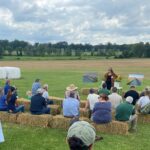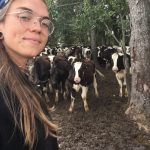Throughout 2022 and 2023, Melissa Frost, biology and chemistry teacher at Buchanan High School, joined the KBS LTER through our Research Experience for Teacher (RET) program. The NSF-funded RET program partners teachers with scientists to assist in ongoing research in the lab, as well as providing the teacher the opportunity to develop their own research project. Melissa joined Sarah Evan's lab, and worked with scientists Jennifer Jones and Caitlin Broderick. Melissa embraced the RET as a chance to integrate more research and data into her teaching. "Participating in a RET program allowed
The ABC’s – Agriculture, Beneficial Beetles and Conservation: Reflections from an LTER Fellow
Cynthia Fiser is a graduate student in Doug Landis's lab in the Michigan State University Department of Entomology. Her research looks at the impact of perennial prairie strips on the dispersal of ground beetles in row crop agriculture. Rolling hills of wheat, corn and soybean are a beautiful and nostalgic feature of the summer landscape in the Midwest. Here, agriculture is as much a part of the culture as the economy – anyone who attends a county fair would agree! However, the pressure placed on our agricultural landscapes to meet global demands for food, fuel and fiber takes a toll on
Little strips of prairie can go a long way
New research out of MSU shows that it is possible to manage farmland to address two challenges simultaneously – protecting biodiversity and maintaining ecosystem services. The key is to strategically place native perennial vegetation within agricultural systems, using the innovative practice of prairie strips. Today, 38% of the landscape in the Midwest is planted in row crop agriculture. “We need to make this land habitable for species for the ecosystem services the increased biodiversity can provide to the farms” said Lindsey Kemmerling, the first author of the MSU-led study
Prairie strip and soil health farm field day to be held in Cassopolis on August 26th
CASSOPOLIS, Michigan— A farm field day centered on prairie strips and soil health will be held on Friday, August 26th (September 2nd rain date) from 1:00- 3:00 p.m. at the Edward Lowe Foundation. The field day will feature speakers including farmers, land managers, and soil scientists who will describe the implementation, management, and soil health benefits associated with on-farm prairie strips. The event is free and open to the whole family and will include a soil pit demonstration, a wagon tour of prairie strips and refreshments. This field day is supported by Michigan State
Transforming Michigan’s agricultural landscapes – Do prairie strips diversify insect communities in squash production?: Reflections from an LTER Fellow
Jen Zavalnitskaya is a graduate student in Zsofia Szendrei's lab in Michigan State University's Department of Entomology. Her research interests include plant-insect interactions, insect behavior, integrated pest management, and agroecology By the time I began my PhD, I knew I was passionate about promoting the biodiversity of agricultural landscapes. From my masters research in Zsofia Szendrei’s lab, I learned that the ways farmers manage their fields plays an important part in insect pest dynamics. However, the local landscape plays a large role as well. This creates a challenge,
Prairie strip ecology, art, and advocacy in the LTER: Reflections from an LTER Fellow
Corinn Rutkoski is a graduate student in Sarah Evan's lab at the Kellogg Biological Station. She is broadly interested in the use of perennials in agricultural systems, science policy, and soil health. Her research path has been propelled by a reciprocal inspiration among ecology, conservation, and creativity. In September 2018, Lisa Schulte Moore was scheduled to give a seminar at KBS titled Prairie strips improve biodiversity and multiple ecosystem services from corn-soybean croplands. At the time, I was a technician in Sarah Evans’ lab at KBS, considering graduate school
Species interactions in prairie strips: Reflections from an LTER Fellow
Graduate researcher, Alice Puchalsky, is a Ph.D. student in Dr. Nick Haddad's lab at Michigan State University. Her research focus is on moths, butterflies, and interaction networks. When I began graduate school, I did not imagine myself eagerly watching a caterpillar writhe around in a plastic cup, wondering about its fate. But, that is where I found myself this past summer. I also did not imagine the delight I would feel in checking on that caterpillar the next day and finding that approximately 30 very small parasitic flies had emerged from that caterpillar’s body. I was hoping that
Scaling-up conservation practices: How much can farmers afford?
East Lansing, MI – Prairie strips planted into row crops have the potential to contribute a suite of ecosystem services, such as improved soil health, water quality, and wildlife habitat. When it comes to implementation, farmers have to weigh these environmental benefits as well as the economic cost of taking land out of production. In a new study, released online by Land Economics, Michigan State University (MSU) researchers find that 20% of corn and soybean farmers in the Eastern Corn Belt are willing to convert 5% of their largest corn-soybean fields to prairie strips if paid the same
Kellogg Biological Station joins multi-state effort to increase the adoption of prairie strips across the Midwest
Before there were the gently rolling hills of farmland and forest we see today, southwest Michigan’s landscape included large areas of prairie habitat. Dominated by wildflowers, grasses, and sedges, these habitats were maintained by periodic fires and included oak barrens, dry sand prairies, and wetland prairies. Today, only a few remnants of Michigan’s historical prairies remain on the landscape. Prairie strips, a conservation practice in row crops that protects soil and water while providing habitat for wildlife, are one way to restore these habitats to the
Using prairie strips to understand the value of diversifying agricultural landscapes: Reflections from an LTER Fellow
MSU graduate researcher, Lindsey Kemmerling, is a PhD student in Dr. Nick Haddad's lab at Michigan State University's Kellogg Biological Station. Society today faces three immense ecological challenges: preventing the loss of biodiversity, adapting to climate change, and sustainably supporting a growing population. Humans have caused a global biodiversity crisis, with new studies continuing to reveal stunning rates of biodiversity decline across the entire tree of life. Simultaneously, we are presented with the challenge of sustainably and equitably supporting a growing human
